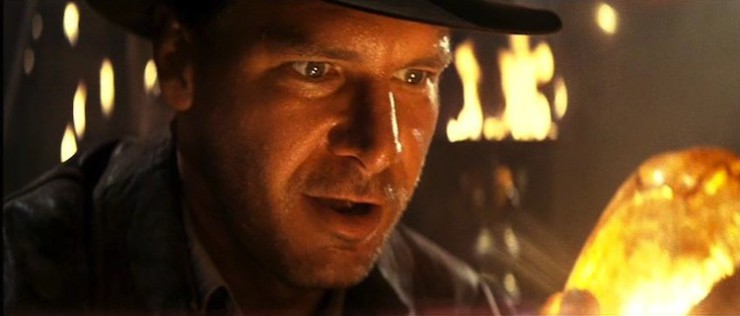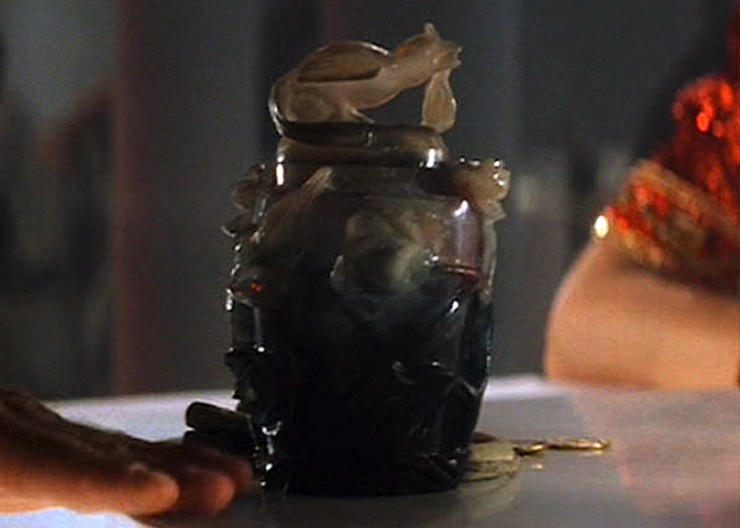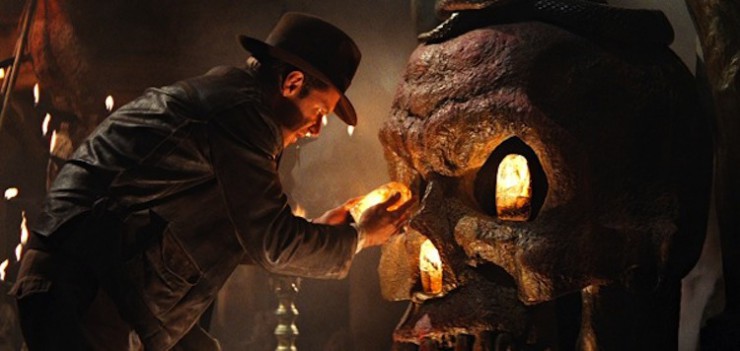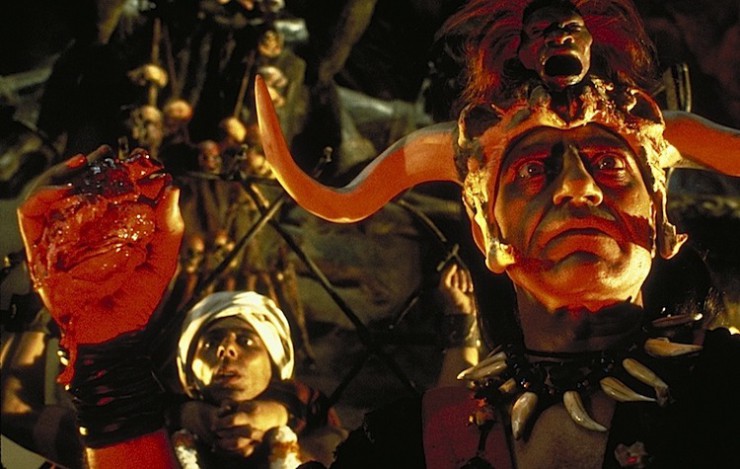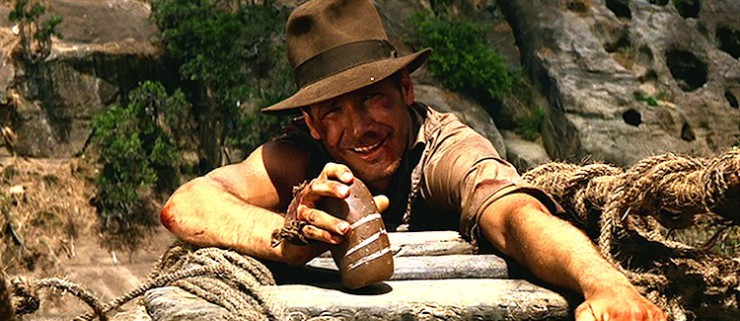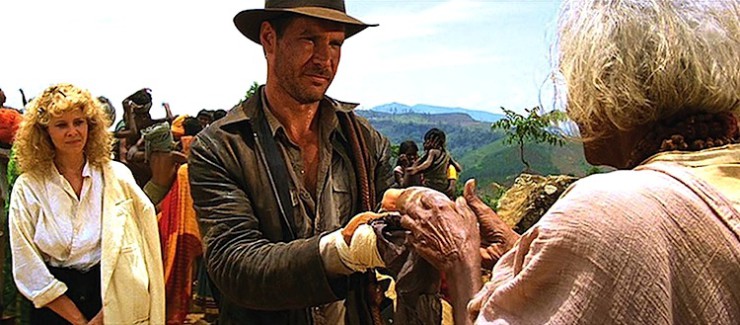The main Indiana Jones trilogy is essentially a conversion narrative in which the hero never converts… which is a little strange. Why bother with that narrative if you’re not going to fulfill it? Indy also exists in a universe where all the religions are seemingly true, based on the very real powers each movie’s main artifact displays. Here is the second of three (lengthy!) posts exploring the weird religious universe that the first three Indiana Jones films create.
In my last installment, I tackled Raiders of the Lost Ark’s big relic, the Ark of the Covenant, and hopefully avoided getting zapped by the wrath of Yahweh. Now I’m inflating an improbable life raft and diving straight into the Hinduism of Indiana Jones and the Temple of Doom! I’m going to look at the ways the film uses real-life artifacts, and try my best not to talk about chilled monkey brains. I mean, come on, movie.
Temple of Doom immediately disorients us, as we hear “Anything Goes” being sung in Mandarin by a white woman with a Middle American accent—but more importantly, the film is set two years before the action in Raiders. We’re dealing with a younger Indy, and the film wastes no time in showing us our rakishly dapper hero in a white suit that is as metaphysically far from his professorial tweeds as Club Obi Wan is from Marshall College. The opening gambit adventure involves a Shanghai gangster named Lao Che, a giant diamond called The Peacock’s Eye, and the ashes of Nurhachi, First Emperor of Manchu Dynasty:
In this opening we glancingly see that Indy is just as knowledgeable about Chinese history and artifacts as the Western ones he found in Raiders. While it’s believable that a kid raised by a religious father (which Indy was, which I’ll talk about in tomorrow’s post on Last Crusade) would be able to rattle off the Hebrew Bible’s account of the Ark, it’s a little less believable that one archaeologist would be comfortable with the variety of histories and cultures that Indy seems to know. (An academic Mary Sue, perhaps?)
This younger Indy has friends all over the world who are willing to follow him into adventure, as is evidenced by the introduction of the doomed waiter and Short Round. He is also obviously more callow in this adventure than he is a few years later when he pursues the Ark. While Lao Che treats the urn with reverence and awe, Indy doesn’t seem to care even a little about the remains of the Emperor—he just wants his diamond. He also doesn’t care whether Willie Scott lives or dies, which, granted, they only just met, but it’s still problematic that he’s threatening her with cutlery. As the adventure continues, however, the film becomes a more serious fight between darkness and light. You remember how I said in the last post that Indy starts out as a jerkface? After he, Willie, and Short Round crash in the wilds of India, he has his first onscreen brush with the supernatural, and it does change him, as we’ll see…but it doesn’t convert him.
Temple of Doom, or Saivism for Westerners!
Now I should start by saying I am by no means an expert on Hinduism. As I tended to focus on Western religion, and my specific studies were in American Religious history, the development of saivism, the worship of Shiva, is about 8,000 miles outside my wheelhouse. But, here goes. The Purana Linga speaks of Shiva, the supreme god, as “signless, without color, taste or smell, beyond word and touch, without quality, changeless, motionless.” However, in order to allow Shiva’s worshipers to concentrate on something during prayer, his followers had to make him at least slightly manifest in the world. So they turned to linga:
Linga are conical stones, usually with three lines carved or painted into them. This one is part of a shine in the Kalimaam Temple of Bangalore, India. By using linga as a focal point, a worshiper can represent the god and the act of creation itself with one simple symbol. The Purana Shiva describes the deity stepping into the world from a pillar—or lingam—of fire, as proof that he is the strongest of the gods. The linga can simultaneously recall that moment, and represent active creative energy bursting into the universe, with Shiva Himself seen as an inexhaustible font of life.
Linga can also be seen, easily, as dicks. That’s how the Victorians saw them, as British repression clashed with Hindu culture in India. This is alluded to in Temple of Doom—set before World War II and the subsequent Indian uprisings that finally loosened Britain’s grasp on the world—as we learn that the big spiritual Maguffin of the film are the Sankara stones (linga) which are intricately tied to the fertility of the village.
The movie itself has a strange push and pull between respect for the Hindi culture and blatant racism. The stones themselves and the villagers, are treated well both by the film and by Indy, and it’s more in the garish excesses of the state dinner and the Thuggee cult ceremonies that the film fetishizes its Indian setting. And about those Thuggees… the Thuggee cult was historically a thieves’ guild, essentially, and had far more in common with, say, the Italian mafia than a religious cult. Thugs (The Hindi word means “thief” or “deceiver”) would infiltrate caravans, murder travelers, and make off with whatever valuables they could carry. Sometimes they’d take the children of the travellers to raise them as Thugs as well. A member could pass his position down to his son, and families spent generations within the Thug family. And about the Kali, heart-ripping part of this story? The Thugs sometimes claimed to be acolytes of Kali, but it wasn’t a requirement, and they certainly didn’t see themselves as an evil cult wrangling for world domination. And, maybe most important: Kali is not an “evil goddess.” She’s the goddess of change, one of the consorts of Shiva, and while she may be fearsome in appearance she’s not a demon in the Western sense of that word. She’s not out to get you, spiritually speaking. In fact, she’s beloved by some sects of Hinduism, being seen as a fierce, protective Mother to her devotees. She is also darkness itself:
Dancing mad with joy,
Come, Mother, come!
For Terror is Thy name,
Death is in Thy breath,
And every shaking step
Destroys a world for e’er.
Thou “Time”, the All-Destroyer!
Come, O Mother, come!
Who dares misery love,
And hug the form of Death,
Dance in Destruction’s dance,
To him the Mother comes.
Indy seems to come into the story with strong knowledge of Shiva, and of the Sankara Stones. (While it’s believable that an old-school archaeologist who walks the line of pure treasure hunter would at least know of the Stones, it still stretches credibility that he’s an expert in Hinduism, and as fluent in Hindi as he seems to be.) He believes the Stones can lead to “fortune and glory” and seems to view the Sankara quest in the same way he must have viewed Nurhachi’s Urn—as a path to money. (We get no indication that this younger Indy thinks artifacts belong in a museum, and we’ve already seen his willingness to make black market trades.) While he is respectful to the village elder who says, “We prayed to Shiva to help us. It was Shiva who made you fall from the sky…” he privately scoffs at the idea when Shorty asks about it, referring to it as a “ghost story.” Once he realizes he’s dealing with a Thuggee cult, however, he seems to take things more seriously. But even this is a purely materialistic fear—the cultists scare him, not their religion. When he embarks on his main adventure to discover the Thuggee ceremony, he first finds an inscription saying “Follow in the footsteps of Shiva, do not betray his truth.” “Shiva’s truth” is never defined, however, and Indy doesn’t take the time to ponder it. This proves problematic.
So, long story short: Indy wanders onto a leftover Goonies set and finds three Sankara Stones. Indy takes Sankara Stones. Sankara Stones light up like E.T.’s tummy when they’re near each other. Everyone is captured by Mola Raam, the cult leader, who holds a young Prince under his sway. Indy is forced to drink blood and undergo “the black sleep of Kali”…but only after learning that the kidnapped children are digging for the last two Sankara Stones. Lots of heart-ripping and Kali-Maaaa-ing ensues. Everyone escapes. Willie reveals that she’s capable of knocking a man out with one punch only after she’s let Indy and (like, ten-year-old) Short Round do all the fighting. The gender politics in this adventure are problematic.
Anyway, we also learn Mola Ram’s nefarious plot: “The British in India will be slaughtered. Then we will overrun the Moslems. Then the Hebrew god will fall. Then the Christian god will be cast down and forgotten. Soon Kali Ma will rule the world!”
None of this works. While there have been many, often violent, clashes between Hinduism, Buddhism, Sikhism, and Islam in India, Hinduism has never been a proselytizing-type faith. This implies that Kali Ma doesn’t want to rule the world. I mean, she’s been around for a lonnnnng time, if she wanted to take over she would have done it by now. Plus, Mola Ram betrays not only Shiva but his basic lack of religion knowledge in this film: Jews, Christians, and Muslims all worship the same God, Mola. You’ve just said the same thing three times, you redundant son of a bitch! I realize that reviving an ancient blood cult takes a lot of time, but do your homework.
Cut to rope bridge.
Now, remember that problematic moment I mentioned before? When Indy just sort of accepted the idea of “Shiva’s Truth”? Once we’re at the rope bridge this all comes to a confusing head. Indy confronts Mola Ram, and yells, “Prepare to meet Kali…IN HELL!” which, while an admittedly GREAT thing to say to a villain, makes no sense. What does Indy, a secular, pre-Ark, Western academic, mean by “Hell”? And what possible bearing could his idea have on a practicing Hindu? “Hell” in Hinduism is a realm called Naraka, and it’s usually temporary, similar to the Catholic concept of Purgatory. And while we’re on the topic, Mola will not be facing Kali there, he’ll be facing Yama, the God of Death. So Indy has just told Mola Ram “Prepare to meet [Incorrect God] in a temporary place of punishment where your soul will be readied for rebirth!”
Then it gets worse. A few minutes later, he accuses Mola Ram of “betraying” Shiva. Indy is obviously in the moral right, since Mola Ram is enslaving children, which no aspect of Hinduism would ever condone. However, he might be misunderstanding the gods. Shiva and Kali, in a certain way, are one and the same. They are complementary aspects of creation—energy and pure consciousness, not two separate, anthropomorphic entities. Only by working together can energy (“Shiva”) and pure consciousness (“Kali”) create life. Indy might be assuming that by betraying Shiva, Mola Ram would face the Fearsome Consort Aspect to pay for his crimes? But he’s still treating Shiva and Kali (neither of whom, let me remind you, preside over hell) as separate gods, which is a fundamental misunderstanding of the religion.
LEAH! I hear you screaming. THIS IS UNSPEAKABLY PEDANTIC AND FOR THE LOVE OF WHICHEVER GOD YOU PREFER, WHAT IS THE POINT???
Well, here’s the point: we’ve just gone over how confused Indy is about basic aspects of Hinduism. So how is it that when he invokes Shiva, the stones begin to glow? They burn Mola Ram (they’ve never burned Indy, even when they glowed before) which causes him to fall from the bridge. Clearly someone is pissed at him. More interesting to me is this: why is the extremely Western Indy capable of wielding the stones against a follower of Kali? Since there isn’t really heresy in Hinduism, in the sense that there is in Christianity or Judaism, what does “betraying Shiva” entail? What does Indy mean by those words? And how can this non-believer recite a few Sanskrit phrases to activate the Stones and use them as weapons?
After they all return to the village and the Stone is replaced in its shrine, the elder smiles at Indy, “Now you can see the miracle of the rock.” Indy replies, “Yes, I understand its power now.” But…what? So has Indy converted to Saivism? He seems to think the rock itself has power, but that really isn’t the point? Dr. Jones, you apparently live in a universe where both the God of the Hebrews and Shiva have the power to manifest in icons and defeat their enemies. This is significant.
So, rather than the straight ahead conversion narrative of Raiders of the Lost Ark, we get an action movie version of The Darjeeling Limited. A Westerner learns to be a little more spiritually open after some rough times in India, but he doesn’t commit to his journey enough to truly change his life. If we want to take the film’s chronology at face value, the Indy we meet in Raiders is nearly as cynical as the one we meet in Temple, despite having already encountered a religious relic that can exert power against evil. The only shift is that in his two later adventures the only “glory” he seems to seek is as an archaeologist, and while Marcus pays him, he’s far more invested in the idea of historical artifacts having safe homes in museums. (Perhaps this is a shift back to the idealism of his youth, which we see in the opening of Last Crusade?) However all of his adventures, East or West, opening gambit or main event, have on thing in common: Indy is only interested in the icons as historical finds, not as religious artifacts. Now, for the next film he leaves India for the Middle East, and tracks down one of the Biggest Kahuna of Christian lore—will the conversion narrative work this time?
Leah Schnelbach would almost be willing to go through the Kali MAAA ritual. How cool would it be to see your own heart? Come chant at her on Twitter!










